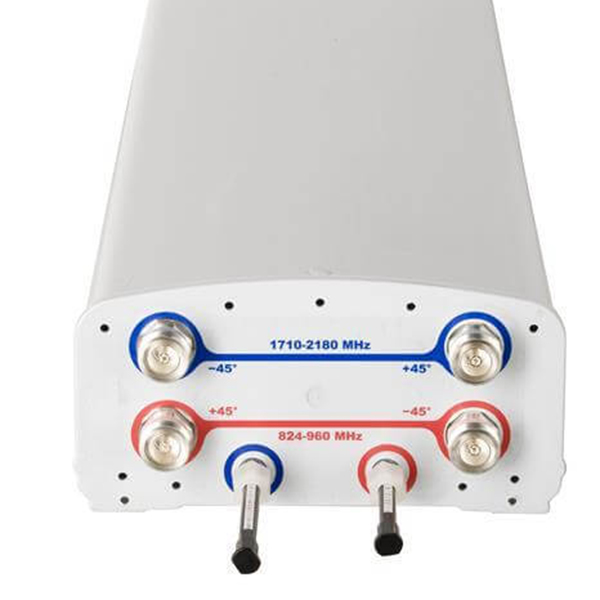820-960/1710-2170 xxpol Four-Port Electrical Downtilt BTS Antenna of Performance and Application

The 820-960/1710-2170 xxpol four-port electrical downtilt BTS antenna represents a significant advancement in cellular infrastructure technology. Its multifaceted design, incorporating sophisticated signal processing and adaptable beamforming, addresses the escalating demands of modern high-density wireless networks. This analysis dissects its core functionalities, highlighting the interplay of its key features and their synergistic impact on network performance.
Beyond the Specifications: Unveiling the Synergistic Functionality
This antenna transcends the limitations of its predecessors through the ingenious integration of several key technologies. Its operational frequencies, polarization scheme, and electrical downtilt mechanism are not merely individual components; they are intricately interwoven to optimize signal propagation and maximize network capacity. The four-port configuration further enhances this synergy, facilitating efficient signal distribution and advanced signal processing techniques.
Frequency Agility and Polarization Diversity: A Symbiotic Relationship
The antenna's dual-band operation (820-960 MHz and 1710-2170 MHz) caters to both legacy GSM and contemporary LTE/5G technologies, maximizing spectrum utilization. Crucially, the xxpol (dual polarization) design further amplifies this advantage. By simultaneously transmitting and receiving signals in two orthogonal planes, the antenna effectively doubles its spectral efficiency, mitigating interference and enhancing overall throughput in congested environments. This is not merely an additive effect; it's a multiplicative one, leading to exponential gains in capacity.
Electrical Downtilt: Dynamic Beamforming for Optimized Coverage
The inclusion of electrical downtilt represents a paradigm shift in antenna deployment. Unlike the static nature of mechanical downtilt, this feature provides dynamic control over the antenna's radiation pattern, allowing for real-time optimization based on network conditions and user demand. This capability is particularly crucial in heterogeneous environments, where signal propagation is influenced by numerous factors such as terrain, building density, and user distribution. The ability to remotely adjust the downtilt angle minimizes signal leakage into undesirable areas, reducing interference and enhancing the signal-to-interference-plus-noise ratio (SINR).
The Four-Port Advantage: Parallel Processing and Enhanced Resilience
The four-port configuration moves beyond simple signal distribution. It enables advanced signal processing techniques such as spatial multiplexing and beamforming, significantly enhancing network throughput and resilience. This allows for more efficient allocation of resources, mitigating congestion and improving the quality of service (QoS) for individual users. Furthermore, the redundant ports contribute to improved system robustness, ensuring continued operation even in the event of partial system failure.
Applications and Implications: Shaping the Future of Wireless Networks
The 820-960/1710-2170 xxpol antenna is not merely a technological upgrade; it is a foundational element shaping the future of wireless network architecture. Its applications extend across a wide range of scenarios, from dense urban environments to sparsely populated rural areas. The dynamic capabilities of the antenna translate into tangible benefits, including:
- Enhanced Network Capacity: The synergistic effect of frequency agility, polarization diversity, and adaptive beamforming leads to a significant increase in overall network capacity.
- Improved Signal Quality: Precise control over signal propagation ensures consistent and high-quality service for all users.
- Reduced Operational Costs: Optimized coverage minimizes the need for additional base stations, lowering infrastructure costs.
- Scalability and Future-Proofing: The flexible design ensures adaptability to evolving network demands and future technological advancements.
Conclusion: A Catalyst for Network Evolution
The 820-960/1710-2170 xxpol four-port electrical downtilt BTS antenna represents a significant leap forward in cellular technology. Its sophisticated design, combining frequency agility, polarization diversity, and adaptive beamforming, delivers substantial improvements in network capacity, signal quality, and operational efficiency. This antenna is not simply an upgrade; it is a catalyst for the ongoing evolution of wireless networks, paving the way for future advancements in high-density, high-throughput communications.
FAQs
What is the difference between electrical downtilt and mechanical downtilt?
Electrical downtilt involves adjusting the phase and amplitude of signals within the antenna to change its radiation pattern, while mechanical downtilt requires physically tilting the antenna. Electrical downtilt offers remote adjustment capabilities and more precision, whereas mechanical downtilt is a fixed setting that may require manual intervention.
How does dual polarization (xxpol) improve network performance?
Dual polarization allows the antenna to handle two independent signals simultaneously by using two perpendicular planes. This effectively doubles the capacity of the antenna, improves signal quality, and reduces interference, making it ideal for high-density areas.
Can the 820-960/1710-2170 xxpol antenna be used in both urban and rural settings?
Yes, the 820-960/1710-2170 xxpol antenna is versatile enough to be used in both urban and rural settings. Its electrical downtilt feature allows for optimal coverage adjustments in urban areas, while its robust design ensures reliable service in rural environments

 Mobile Signal Booster
Mobile Signal Booster